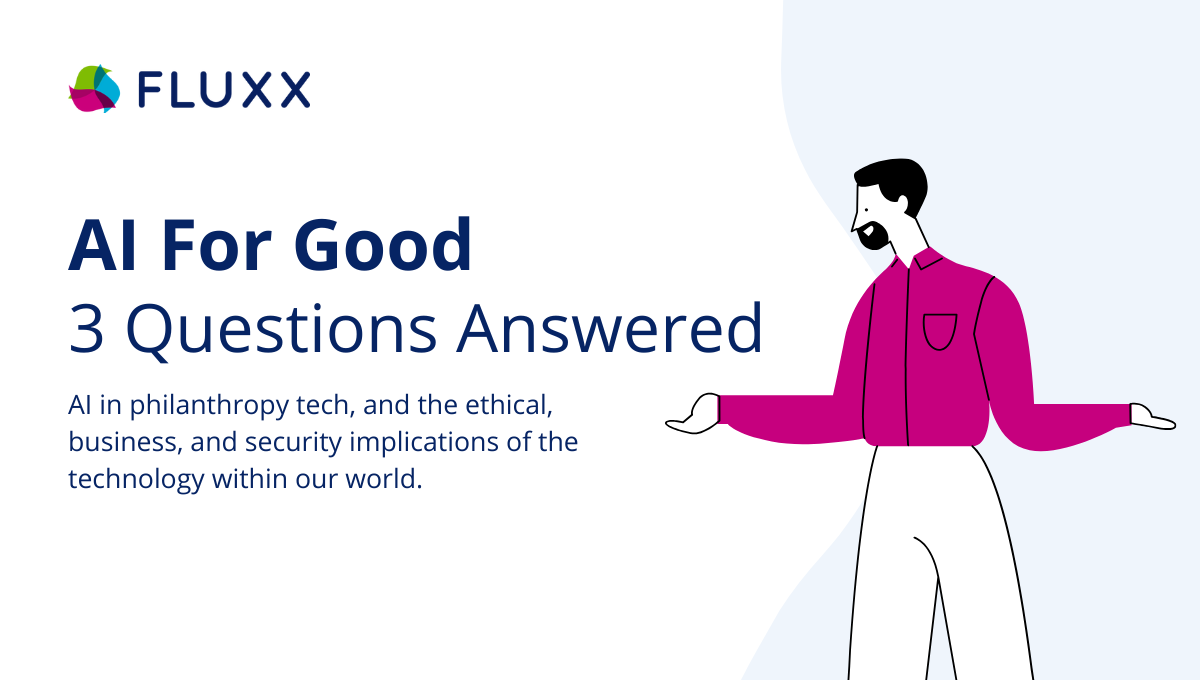 Fluxx and PEAK recently hosted a webinar focusing on AI in philanthropy tech, and the ethical, business, and security implications of the technology within our world. Kerrin Mitchell and Fintan Kelly from Fluxx were joined by Brandolon Barnett from Humantias.ai and Saurabh Gupta from Gyan-i to discuss all things AI.
Fluxx and PEAK recently hosted a webinar focusing on AI in philanthropy tech, and the ethical, business, and security implications of the technology within our world. Kerrin Mitchell and Fintan Kelly from Fluxx were joined by Brandolon Barnett from Humantias.ai and Saurabh Gupta from Gyan-i to discuss all things AI.
The presentation touched on a wide range of topics, starting with a primer on where AI and machine learning are now and how it’s evolved to this point over the last few years. Taking off from there, the team went on to discuss the impact this technology has had on philanthropy and what the future may look like with AI in the picture. The conversation then turned to ethics and responsibility - how will philanthropy continue forward with AI in a responsible and ethical manner. Not only the human side of how we leverage these tools to interact with others, but also the security and privacy risks that may arise as things evolve.
The webinar was packed with knowledge and insight, which you can hear by viewing the OnDemand version here. For this article, we wanted to highlight some of the most compelling questions brought up during the webinar, as many may be thinking about what AI means for philanthropy and its future.
Q: What are the AI concerns about quality versus quantity? If organizations are seeking to generate full length content while simultaneously seeking to simplify verbose content, are we wasting resourcing instead of optimizing to maximize impact?
A: There's a phrase in marketing that “content is king” and if you think about how easy it is to generate content through AI and just roll out endless reams of content. That may mean that content may no longer be king and the shape of content will change. Additionally it may be harder to trust what you see or to really invest in the content that you come across, just because there's such a sheer volume of it. What organizations really need to think about is that AI can be a tool for first drafts, but you need to really maintain the human touch. AI will be there to help generate those foundations and summaries, but that human touch is going to be critical to differentiate content more than ever before. That's how the paradigm around content is probably going to need to shift in the coming years.
Q: What does AI adoption look like in a grants management platform? What governance and security concerns are arising with this adoption?
A: Fundamentally, any tool that AI is adopted as a component needs to measure real value and purpose, and not just as a gimmick. Most importantly is that we must be informed and inform customers about the tools and provide clarity on how any AI tool may potentially be using data within the product. It is a complex situation and you want to make sure that it provides meaningful content while protecting privacy and security in the process.
A future grants management system infused with AI has many potential uses, such as reviewing grant applications - but not approval, as this would need to be a human element. However, it could be used to summarize and identify whether the application checks all the requirements for a program area. It can speed the time to determine if there is enough to move that application to the next stage. You will also see this being used on the grantee side with content creation and helping with that application process. There are plenty of possibilities, but the important thing to consider is whether it provides tangible, useful value, and that there is transparency on how it’s used and how data is impacted through its use.
Q: With the potential risks AI poses, do you think that new companies will arise to detect and thwart any AI security attacks, much like spyware and anit-virus did for the rise of the Internet?
A: The good news is the big companies are already doing a lot of good work. Just to give you an example, Microsoft analyzes six hundred billion data points every month on the AI side of things to beef up their security capabilities and endpoint solutions.
There is a suite by Microsoft called the Defender endpoint suite. It spans from endpoint protection to cloud security solutions as well. Most of these solutions are available to nonprofits and foundations alike, through TechSoup. The best advice here is to leverage what is available to you, look at your existing providers, see what they're already doing, and then invest in those capabilities because that's the new normal going forward.
These were just some of the questions and topics covered with the panelists. You can watch the entire webinar OnDemand here.